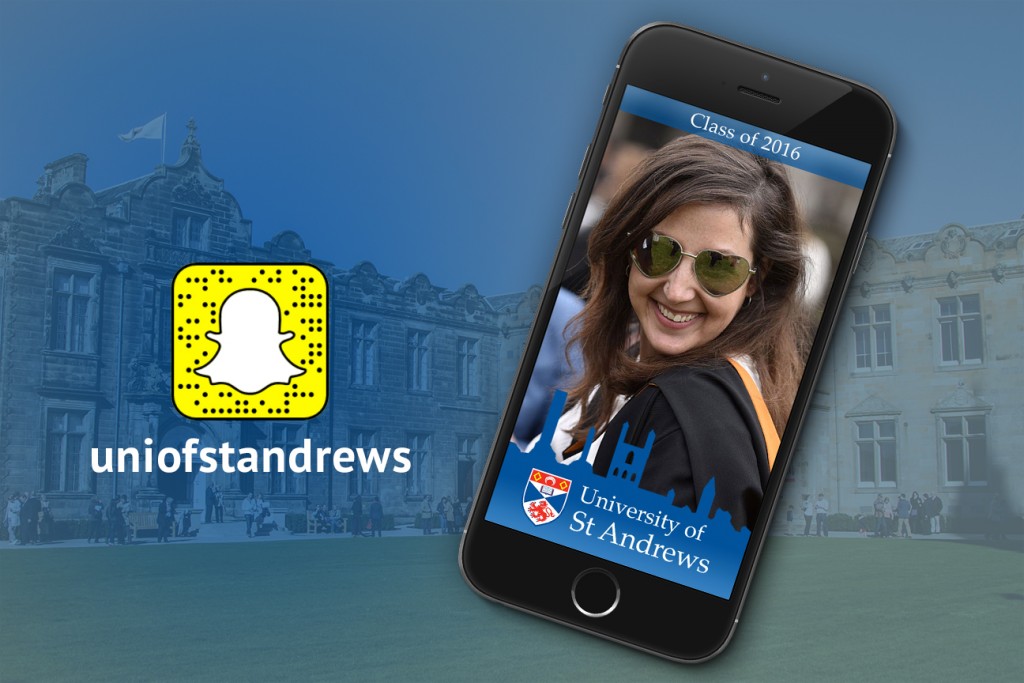Graduation 2016 social media analytics
The University’s social media activities for graduation 2016 were shaped by three main aims:
- to increase following, reach and awareness by producing shareable content and by capitalising on high profile graduation guests and participants
- to drive engagement through multimedia content (video interviews), user-generated content and strategic hashtags
- to experiment with new and previously under-used social media platforms – namely Snapchat and Instagram.
This blog post gives a run-down of performance across the University’s Facebook, Twitter, Instagram and Snapchat accounts during graduation week, followed by recommendations for future campaigns.
The most popular posts on Facebook (with both high reach and engagement) were photo albums from the graduation ceremonies.
These included audience shots of Younger Hall, candid photos from the post-graduation parade and informal celebration shots of graduated students gathering in the Quad. Given the excellent reception that this content received, a Facebook album per graduation ceremony should be included in the 2017 graduation social media strategy.
The posts with the lowest reach were the daily reminders of live streaming (between 600 and 700 people compared to over 56,000 for the most popular posts).
However, these posts generally had very high engagement rates (10% – 12%) meaning that a high proportion of people who saw the posts took action – in this case, clicking the link through to the live streaming page.
In the future, using a scheduling tool like Buffer will identify optimum times to post and this may help to boost the reach of these posts.
The most popular tweets posted during graduation were the two quotes from Neil Gaiman’s honorary graduation speech.
“@neilhimself reminds us that the works we study and teach in this institution belong not only in the library, but also beyond its walls.”
— Univ of St Andrews (@univofstandrews) June 21, 2016
“Things change because people imagine” – @neilhimself #Saintsof2016
— Univ of St Andrews (@univofstandrews) June 21, 2016
These were very widely shared and engaged with because Neil Gaiman retweeted to his two million plus followers.
This is exactly the sort of high profile social media engagement that the University should aim to achieve.
The hashtags #Saintsof2016 and #Saintsof16 were also well engaged with and proved useful for identifying user-generated content to retweet.
Without using a third-party tool such as Iconosquare or Buffer, it is very difficult to gauge success on Instagram as the platform itself provides very minimal analytics.
However, at the time of writing, the most liked posts of graduation week were:
A photo posted by University of St Andrews (@uniofstandrews) on
The first day of graduation saw the highest number of Instagram posts (28 in total), with the first couple of posts gaining the highest engagement and then tailing off thereafter. This suggests that it may be more effective to post one or two carefully selected highlights from an event rather than take a “live-post” approach.
Strategy was adjusted after the first day, and the two or three posts made throughout each of the following days on a variety of topics were much more popular.
Snapchat
As one of the most popular social media platforms for the student-age population, the University decided to use a Snapchat geofilter for the very first time over graduation.
Geofilters are location-specific branded filters that people can choose to overlay on their snaps (or photos, for the uninitiated). Here are some reasons why universities might want to capitalise on this technology.

Over three days, the Snapchat geofilter received 16,999 views and 316 uses – so a 1.8% use rate.
It is hard to evaluate the success of the geofilter, given that information on average use rates is scarce. One positive takeaway is that people were very active on Snapchat, but further research is needed on targeting the filter to gain more uses.
Recommendations
Graduation 2016 did see an increase in engagement, reach and following across all University social media accounts. However, there are a few pointers to bear in mind for the future that will improve the success of any campaign.
Strategic hashtag use
Hashtags have two main purposes:
- Social listening – to track conversations on specific topics and events, and to gather user-generated content. #Saintsof16 fulfilled this purpose for graduation.
- Gaining exposure – by piggybacking on a popular hashtag you can increase your audience. #NeilGaiman is an example of this.
If a hashtag serves neither of these purposes then it shouldn’t be used.
Link shortening
Each social media post should have a specific aim relating to the campaign strategy. Often, this is to drive traffic to a specific webpage – for example, graduation live streaming. Using Bitly (a link shortening tool) saves space in posts and also provides analytics on link clicks.
Scheduling
As mentioned earlier, a scheduling tool like Buffer should be used in advance of a big event to schedule as many posts as possible. This ensures that posts are published at optimum times for maximum impact, avoids duplication of content and frees up staff time.
If scheduled in advance, all posts can be QA-ed in accordance with acceptance criteria which will improve consistency, e.g. correct hashtags, links shortened, quality images that display properly.
Buffer also provides additional analytics which are very useful, particularly for Facebook and Instagram.